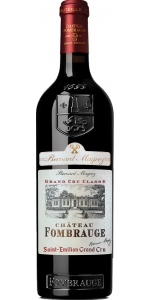Wine from Fombrauge
The estate goes back to the 16th century, which makes it one of the oldest châteaux in the Saint Emilion region. The first harvests were carried out in 1599. The origin of the name “Fombrauge” comes from the old Occitan terms “fons brogiera”, which means “spring surrounded by heather and bushes”. The spring and its fountain still exist today, powerfully masonry in cut stone in the heart of the estate's vines. Originally spelled “Fontbrauge” or “Fonbrauge” interchangeably, it was in the 19th century that the current spelling “Fombrauge” was formalized.
The beautiful 17th century old country manor was originally the cloister of the town’s Carthusian Monastery. Owned by Jacques de Canolle in 1466, the estate later belonged to the Dumas de Fombrauge family, who implemented the first quality winemaking in the estate in the 18th century. Jacques François Dumas inherited the estate in 1758 and the Taffard Saint-Germain family took it over in the 19th century and continued to develop the vineyards.
Bernard Magrez bought the estate in 1999 and made the necessary investments to improve the property by restructuring the vineyard and the layout of the cellars, and restored the charterhouse and the gardens to magnifiy the reception venues. These renovations elevated Chateau Fombrauge to the highest level of quality and produce one of the greatest wines of Saint Emilion. In 2012, Château Fombrauge was promoted as Grand Cru Classé, rewarding the efforts of modernization and continuous improvements.
Fombrauge Saint Emilion is made from 96% Merlot and 4% Cabernet Franc.
Château Fombrauge 2020 has a dark red hue, intense fruit aromas and elegant tannins that offer a generous mouthfeel rarely seen in wine so young.
The nose reveals aromas of cherries, blackberries and raspberries, along with spicy notes.
On the palate, the wine i round, soft and silky. Its deep richness, matched with a nice freshness and a long and mellow finish, make it already a great Château Fombrauge, with a long ageing potential.
Chateau Fombrauge Saint-Emilion Grand Cru's food pairing
- back
Selected Options
Wineries
Categories
Pricing
Countries
Regions
Grape Types
Wineries
Organic/Free Shipping
2021 Rossj-Bass displays the main features of the vintage well, with intense fruit concentration and floral notes. The nose shows ripe citrus notes of lemon peel and orange evolving into tropical fruits. The richness of the nose and the same notes are reflected on the palate, where remarkable acidity balances the fruit concentration. The wine is rich, full-bodied and creamy, with a long finish.
Review:
The 2021 Gaja Rossj-Bass starts off with very, crisp, green fruit and much more Sauvignon Blanc dominant aromas of grassy, bright, fragrant green apple and green pepper - all very bright and cheerful. Then Chardonnay seems to take over in the medium-full bodied and pleasing creamy texture of the wine. This is balanced again by the tangy, juicy acidity of Sauvignon. This is very elegant blend of Sauvignon Blanc aromas and zestiness and the textural comfort of Chardonnay. The name Rossj is a nickname of Angelo Gaja’s second daughter, Rossanna.
-Wine Independent 94 Points
The grapes for this wine were grown in the Oak Knoll District of Napa Valley, where soils are transitional from gravel to silty clay loam. The climate is moderate to cool with marine air until mid-morning and frequent late afternoon breezes that maintain cooler temperatures and ensure a longer growing season. Chardonnay from this region showcase flavors of crisp apple, mineral notes and tropical fruit with good acidity.
Aromas of lemon curd, sweet butter, brioche and sun-ripened peach mingle with notes of nutmeg and vanilla bean. The palate is creamy, with zesty lemon overtones and minerality persisting on the finish.





